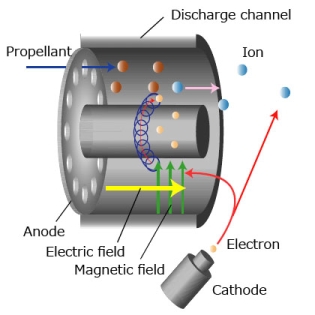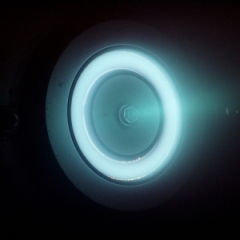Hall Thruster
What is a Hall Thruster?
| |
Hall Thruster are electric propulsion systems applied on satellites. In Hall thruster, ions are accelerated by the axial electric field applied by the anode, therefore Hall thruster are categorized as electrostatic accelerators, and are hence grouped together with, for example, electrostatic ion thruster. Electrons are trapped by the radial magnetic field and the electric field in the channel of thruster and form circulating Hall current, and that's because this thruster gets its name.
Research and development of Hall thruster started already in the 1950s and 60s in the US and the Soviet Union, but US changed the line from Hall thruster to Ion thruster. Soviet union continued the research and development and resulted in the successful application of Hall thruster onboard the Soviet satellite Meteor launched in 1971. Since then research activities were continued especially in the Soviet Union (Russia), where Stationary Plasma Thruster, SPT, were developed and more than 100 SPT have been operated their missions. |
|
|
How does it work?
| |
Hall thruster consist mainly of 4 parts: the anode to establish the potential, a channel where propellant is discharged and accelerated, a magnetic circuit to trap electrons and the cathode to supply electrons. Depending on the design of the channel, Hall thruster are further categorized into two types:
 Magnetic-layer type: The length of the channel is longer than its width and its wall is made of insulator. They have a reputation for operation stability and many achievements.(e.g., SPT in Russia) Magnetic-layer type: The length of the channel is longer than its width and its wall is made of insulator. They have a reputation for operation stability and many achievements.(e.g., SPT in Russia)
 Anode-layer type: The length of the channel is shorter than its width and its wall is made of conductor. They have the high efficiency and long lifetime is expected. (e.g., TAL, Thruster with Anode Layer in Russia) Anode-layer type: The length of the channel is shorter than its width and its wall is made of conductor. They have the high efficiency and long lifetime is expected. (e.g., TAL, Thruster with Anode Layer in Russia)
Either type, the principle is the same. Some electrons supplied by the cathode flow into the channel, and drift azimuthally due to the radial magnetic field and the axial electric field, which form Hall current. The propellant is fed throw the anode and diffuse into the channel. Then, neutral particles of propellant are ionized by collisions with high energy electrons in the Hall current and propellant become plasma. The ionized propellant is accelerated by the electric field and exit from channel. The other electrons are pulled by the ionized propellant and create a plume with no net charge.
Its thrust is about 10 mN, but the exhaust speed is about 10 km/s.

|

|
| Principle of Hall thruster |
Operating Hall thruster |
| |
|
Current interests and further information
| |
Our group studies on both Magnet-layer type and Anode-layer type, and we're focusing on the developing of new thruster, the plasma diagnosis by probe and the numerical analysis.
For more information, visit the publications section, or find our group's webpage here. |
|
|



 Magnetic-layer type: The length of the channel is longer than its width and its wall is made of insulator. They have a reputation for operation stability and many achievements.(e.g., SPT in Russia)
Magnetic-layer type: The length of the channel is longer than its width and its wall is made of insulator. They have a reputation for operation stability and many achievements.(e.g., SPT in Russia)